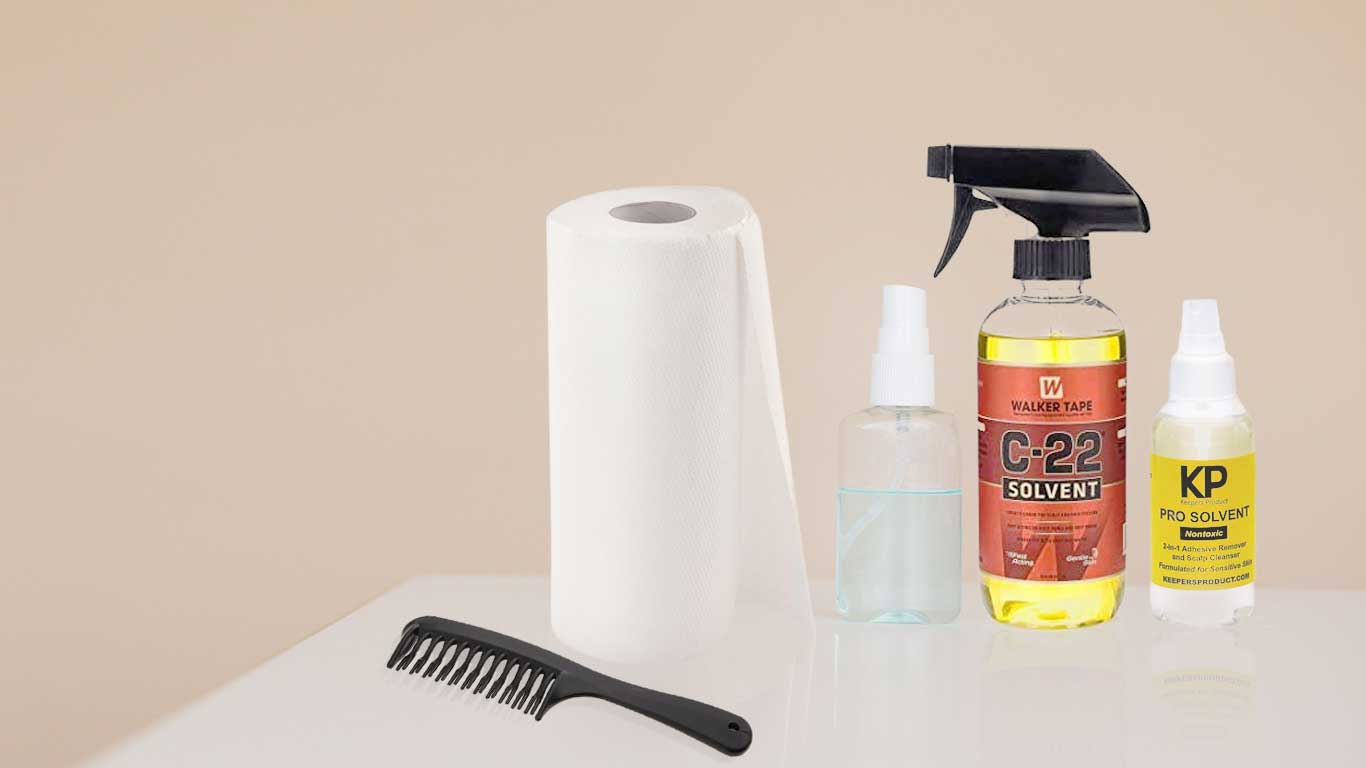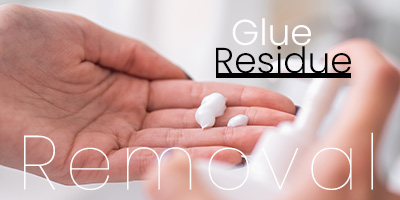How to get glue residue out of your hair or hair system
Posted by Superhairpieces on Sep 30, 2021
One of the minor hindrances with human hair replacement systems — especially when you’re attaching it with wig glue or wig tape — is having the residue of the adhesive get into your hair system, or even worse, your natural hair. This can be hard to avoid as when you’re attaching your hairpiece, it’s always possible that some glue residue makes contact with the hair.
This can also be dangerous as if one pulls, brushes or washes their hair the wrong way, it can be painful and damage the hair as well as the scalp. Luckily for you, we have provided this short guide as to how to remove bonding glue residue from your hair.
What you will need to remove glue residue from your hair system

Which particular brand you get depends on your preferences and which hair system base you have, but in general, it’s always good to have the following both on hand.
- Adhesive remover
- Alcohol (spray)
- Fine tooth comb
- Paper towels
An adhesive remover should be at your disposal regardless as you will need it to remove your hair system. At Superhairpieces, we recommend two adhesive removers in the Walker C-22 Solvent and the KP Pro Solvent.
The C-22 solvent is great for cleaning the scalp as well as hair systems, and can be rinsed off with soap and water. It is fast acting as well as gentle on the skin. The KP Pro, meanwhile, is a non-toxic, non-alcohol 2-in-1 adhesive remover and scalp cleanser that is oil-free, grease-free and residue-free. It is formulated for sensitive skin in particular.
However, it is heavily recommended that you test out these products with a patch test first to make sure you are not sensitive or allergic. The best place to do a patch test is behind the ear.
How to remove glue from your hair or hair system

Whether the glue residue is on your hair or your hair system, the process is mostly the same.
You can use an alcohol spray on the area as it is beneficial for some as opposed to an oil-based adhesive remover. However, alcohol spray (especially a high concentration) can also be too rough and dry which is why an adhesive remover such as the KP Pro Solvent may be ideal.
- Whether you’re using alcohol or an adhesive remover, apply the preferred solvent on the glue residue areas and rub the area using your fingers. Let it sit for a couple of minutes so that it loosens the bond of the glue.
- Afterward, take your fine tooth comb and gently brush your hair towards the front of your hairline. This is so that the residue doesn’t get stuck to the more dense, thicker hairs such as on the sides or back of your head. A useful tip is to brush in the direction of your natural hair growth to avoid further breakage and/or pain.
- The residue should be collected in the comb’s narrow teeth. Use your paper towels to remove it and continue combing until all the residue from your scalp or hair system is removed.
- Use your paper towels to wipe and clean your hair. You can use a cloth as well.
- Wash your scalp and natural hair with shampoo and then rinse afterwards. Remember to never use hot water but rather, cold or lukewarm water. You can repeat this process twice if necessary. Be careful not to irritate your scalp. Condition your scalp and natural hair with a conditioner. You should now be free of any glue residue!
Alternatively, if the glue residue is on your hair system, you can soak it in liquid solvent for a couple of minutes to up to an hour or two and follow the same steps.
Alternative methods to removing glue residue from your hair system
If there is any remaining adhesive residue on your natural hair and you don’t have any alcohol spray or adhesive remover at the moment, or simply just prefer another method, there are alternative methods at home you can make use of.
Mirror or table slide
One method involves applying a plastic wrap on a mirror, table or any other surface that is sturdy. Then, simply slide the hair system base down from the top of the surface to the bottom in one motion only. You will have to press it firmly onto the surface while doing this which is why you should do it on a sturdy surface such as a mirror or table. When you do this, any adhesive, particularly hard-to-remove residue, should separate from the base and stick on the plastic wrap. You should notice less stickiness after one slide.
Repeat the process by sliding the base down from a different angle, but make sure to do it on an untouched part of the plastic wrap so no additional residue is deposited back onto the base. Note that this method should only be used for the lace areas of a base or a full lace base system. It is not recommended for skin bases, thin skin hair systems or any systems which have poly sides as this can stretch out the base and damage it.
Once you’re done, throw out the plastic wrap and wash your hair system with dish soap before rinsing. Apply wig shampoo and conditioner thoroughly before letting it dry.
Dish soap
You can also use liquid dish soap for the entire process if you want a simple method with the least amount of supplies or work needed. Simply apply and gently rub dish soap onto the affected area.
For optimal results, it is recommended to leave the dish soap lather on the residue areas for around an hour or two. After that’s done, rinse your hair system off with lukewarm water before applying shampoo and conditioner. The adhesive residue should be dislodged afterwards.
Peanut butter

Although this might seem crazy or farfetched, peanut butter has proven to be highly effective when it comes to removing sticky residue in general. And you guessed it, it works for glue residue as well.
Similar to dish soap, all you have to do is apply a small amount of peanut butter on the affected residue area and let it sit for half an hour to upto an hour. During this time, the peanut butter should loosen the adhesive bond. Once that’s done, you can wash your hair system and the residue should come off much easier. As always, remember to use shampoo and conditioner afterwards.
Other methods that follow the same procedure include the use of baby, olive or almond oil while lemon juice has also been known to be effective in weakening residue.
Regular maintenance is necessary
Remember that while you may not see any residue on your hair system base, it’s still possible that it is present. That is why it is imperative that you take the utmost care and fully clean the base so that your next installment ensures a strong bond without any complications during the process.
It’s a best practice to regularly maintain your hair system at least once every other week, if not every week. This ensures that your hair system is clean, bacteria-free, continues to last long and finally, adhesive residue-free.
-----------------------
Interested in learning more about wigs, toupees or hairpieces? Browse through our website at www.superhairpieces.com (US & International) or superhairpieces.ca (CAN)
Don’t forget tag us at @Superhairpieces and #Superhairpieces on your social media channels to get a shoutout!
 Likes
Likes



 GBP
GBP












